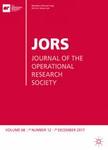版权所有:内蒙古大学图书馆 技术提供:维普资讯• 智图
内蒙古自治区呼和浩特市赛罕区大学西街235号 邮编: 010021

作者机构:Univ Fed Sao Carlos Sao Carlos Brazil Univ Fed Sao Carlos Sorocaba Brazil
出 版 物:《JOURNAL OF THE OPERATIONAL RESEARCH SOCIETY》 (英国运筹学会志)
年 卷 期:2022年第73卷第10期
页 面:2216-2227页
核心收录:
学科分类:12[管理学] 1201[管理学-管理科学与工程(可授管理学、工学学位)] 07[理学] 070105[理学-运筹学与控制论] 0701[理学-数学]
基 金:Sao Paulo Research Foundation (FAPESP) [16/23366-9, 16/01860-1, 13/07375-0] Coordenacao de Aperfeicoamento de Pessoal de Nivel Superior -Brazil (CAPES) National Council for Scientific and Technological Development (CNPq) [309612/2018-7, 313220/2020-4] Fundacao de Amparo a Pesquisa do Estado de Sao Paulo (FAPESP) [16/23366-9] Funding Source: FAPESP
主 题:Production planning lot sizing parallel machines batch splitting mixed-integer programming
摘 要:This paper addresses the optimization of production planning in the white goods sector, motivated by the real case of a home appliances manufacturer. The main characteristics of this productive process are multiple parallel assembly lines with distinct unrelated speeds that vary depending on product type;a tight limit on the maximum number of split batches;multiple product types that share different types of resources;and constraints on production capacity. For the company, it is important to consider all these characteristics in an integrated manner, which results in a complex decision-making process. To provide effective support to decision-making in this context, we propose an optimization model that seeks to meet the demand in the planning horizon considering all the mentioned characteristics, while minimizing the processing times and the number of split batches. The results of computational experiments with instances based on real data provided by the company showed that the proposed approach is effective and presents good quality solutions for the case study, suggesting significant productivity gains if put into practice. They indicate improvements in production times by up to 9.43% and reductions in batch splitting by approximately 55% with respect to the current operation of the company.